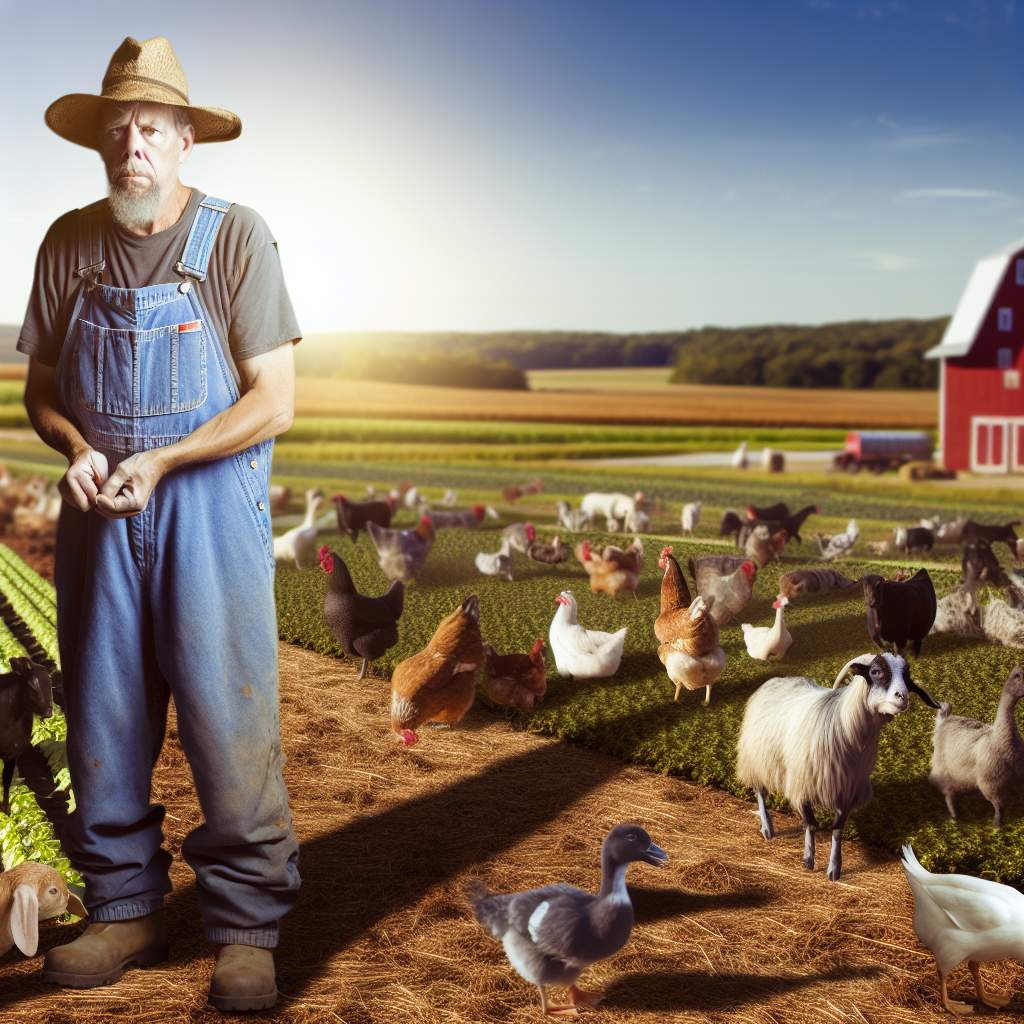Introduction to Small Livestock
Importance for Diversified Income
Small livestock plays a vital role in modern agriculture.
They offer a practical way to diversify income streams on farms.
Farmers can enhance their revenue by integrating small livestock into existing operations.
Additionally, small livestock requires less land and resources compared to larger breeds.
This makes them accessible to a wide range of farmers.
Furthermore, they produce valuable by-products, such as meat, eggs, and wool.
Such by-products can significantly boost a farm’s profitability.
Moreover, small livestock often have lower maintenance costs.
They generally require less feed and housing than larger animals.
By raising small livestock, farmers can reduce their overall production costs.
Small livestock also provide opportunities for direct marketing.
Farmers can sell products at local markets, increasing their income potential.
Additionally, they can foster community relationships through local sales.
Having small livestock enhances food security for families and communities.
Raising a variety of animals ensures a steady supply of food and income.
Transform Your Agribusiness
Unlock your farm's potential with expert advice tailored to your needs. Get actionable steps that drive real results.
Get StartedFinally, small livestock can contribute to sustainable farming practices.
They can help maintain soil health while providing manure for fertilization.
In essence, small livestock management represents a smart farming strategy.
By embracing small livestock, farmers can cultivate resilience and adaptability.
Types of Small Livestock Suitable for Small Scale Farming
Poultry
Poultry is one of the most popular choices for small livestock management.
Chickens are highly productive and provide meat and eggs.
Ducks are another excellent option, offering additional egg varieties.
Furthermore, quail are ideal for small spaces and mature quickly.
Rabbits
Rabbits are increasingly attractive for small scale farmers.
They reproduce rapidly, ensuring a continuous supply of meat.
Moreover, rabbit manure makes an effective fertilizer.
Goats
Goats can thrive on less land compared to larger livestock.
Dairy goats produce milk, while meat goats provide nutritious protein.
Additionally, they can help control unwanted vegetation.
Sheep
Sheep are versatile and can be raised for meat, wool, or milk.
They require minimal space and are recently regarded for their hardiness.
Moreover, their grazing can improve pasture health.
Miniature Cattle
Miniature cattle breed varieties are suitable for confined spaces.
They offer beef production without requiring extensive pastureland.
Additionally, they provide farmers with a charming presence on their farms.
Honey Bees
While not traditional livestock, honey bees greatly contribute to biodiversity.
They are crucial for pollination, affecting overall farm productivity.
Beekeeping can result in honey and beeswax, adding income streams.
Guinea Pigs
Guinea pigs are a great option for smaller operations.
Showcase Your Farming Business
Publish your professional farming services profile on our blog for a one-time fee of $200 and reach a dedicated audience of farmers and agribusiness owners.
Publish Your ProfileThey can be raised for meat in various cultures worldwide.
Furthermore, they require minimal care and space.
Economic Benefits of Keeping Small Livestock
Enhanced Cash Flow
Small livestock can provide a steady stream of income.
Farmers sell meat, eggs, and milk to generate revenue.
These products often have lower production costs.
As a result, profit margins can increase significantly.
Diversified Income Sources
Small livestock help farmers diversify their income streams.
Farmers can raise chickens, goats, or rabbits simultaneously.
This variety reduces dependency on any single crop or livestock.
It also buffers against market fluctuations.
Low Initial Investment
Starting a small livestock enterprise requires minimal capital.
Many small livestock breeds are affordable to purchase.
This makes them accessible to various farming operations.
Moreover, their housing needs are often less complex.
Efficiency in Resource Use
Small livestock utilize farm resources effectively.
They can thrive on pasture and leftover feed from larger animals.
This efficient resource use reduces overall feed costs.
Additionally, they produce manure that enhances soil health.
Health Benefits for Farmers
Raising small livestock can improve food security for families.
They provide fresh, nutritious food directly from the farm.
Furthermore, engaging with animals fosters mental well-being.
Studies show that animal farming reduces stress levels among farmers.
Community Engagement Opportunities
Small livestock farming encourages local interactions.
Farmers often participate in farmer’s markets and local fairs.
These events help build community ties and brand recognition.
Selling locally supports regional economies and fosters collaboration.
Learn More: Greenhouse Farming for Starting a Commercial Business
Management Practices for Health and Productivity of Small Livestock
Understanding Animal Health
Animal health is crucial for productivity in small livestock farming.
Regular health checks ensure early detection of diseases.
Maintain a vaccination schedule to protect against common diseases.
Consider parasite control programs to minimize health risks.
Provide clean water and balanced nutrition for optimal growth.
Proper Housing and Environment
Provide adequate shelter to protect animals from harsh weather.
Ensure proper ventilation to prevent respiratory issues.
Maintain clean living conditions to reduce the risk of disease.
Use appropriate bedding materials for comfort and hygiene.
Consider space requirements to allow natural behaviors.
Nutrition Management
Quality nutrition directly influences livestock health and productivity.
Formulate diets based on the specific needs of each species.
Monitor body condition scores to assess nutritional adequacy.
Showcase Your Farming Business
Publish your professional farming services profile on our blog for a one-time fee of $200 and reach a dedicated audience of farmers and agribusiness owners.
Publish Your ProfileSupplement diets as necessary for vitamins and minerals.
Regularly consult with a livestock nutritionist for optimal plans.
Disease Prevention Strategies
Implement biosecurity measures to limit disease introduction.
Limit animal contact with outsiders to reduce exposure risks.
Establish a routine vaccination program tailored to farm requirements.
Isolate new animals before introducing them to the herd.
Keep records of health and vaccination status for each animal.
Monitoring and Record Keeping
Consistent monitoring of livestock health can lead to better outcomes.
Keep detailed records of health check-ups and treatments.
Track growth rates to identify any deviations from expected performance.
Utilize technology to enhance record keeping and analysis.
Regular assessments help in making informed management decisions.
Education and Training
Investing in staff education is essential for successful management.
Provide training on animal handling and welfare practices.
Stay updated on the latest industry research and innovations.
Encourage staff to participate in workshops and conferences.
Empower your team to take an active role in livestock care.
Find Out More: The Benefits of Growing Sprouts for Livestock and Poultry Feed
Feeding and Nutrition Strategies for Optimal Growth
Understanding Nutritional Requirements
Each type of livestock has unique nutritional needs.
Understanding these needs ensures healthy growth and productivity.
For instance, goats require high-fiber diets for effective digestion.
On the other hand, poultry thrive on protein-rich feeds for optimal egg production.
Selecting Quality Feed
Selecting high-quality feed is crucial for livestock health.
Look for feeds that meet specific nutritional standards.
Be sure to check for ingredients like vitamins, minerals, and proteins.
Additionally, consider purchasing feed from reputable suppliers.
Implementing a Balanced Diet
A balanced diet promotes overall wellbeing in livestock.
This diet should include a mix of grains, forages, and supplements.
Ensure that protein sources are varied and nutrient-dense.
Moreover, don’t forget to include free-choice minerals and salt.
Monitoring Feed Intake
Regularly monitoring feed intake helps identify potential issues.
Changes in consumption can indicate health problems or feed quality issues.
Use feeding records to track usage and adjust as needed.
Also, consider the age and size of livestock when assessing intake.
Adjusting Nutrition Based on Life Stage
Different life stages require tailored nutrition plans.
Young animals need higher protein and energy levels for growth.
Conversely, adult livestock can thrive on lower protein diets.
Additionally, pregnant and lactating animals have increased nutritional demands.
Utilizing Supplements Wisely
Supplements can enhance the nutritional quality of feed.
Consider using protein, mineral, or vitamin supplements as needed.
Showcase Your Farming Business
Publish your professional farming services profile on our blog for a one-time fee of $200 and reach a dedicated audience of farmers and agribusiness owners.
Publish Your ProfileAlways consult with a livestock nutritionist before introducing supplements.
They can help identify any deficiencies and recommend appropriate products.
Ensuring Clean Water Supply
Access to clean water is vital for optimal livestock health.
Animals that are well-hydrated perform better and grow faster.
Regularly check water sources for cleanliness and accessibility.
Additionally, be knowledgeable about the water needs of different species.
See Related Content: Seasonal Gardening for Cold Climate Farmers

Breeding and Reproduction Techniques for Small Livestock
Importance of Selective Breeding
Selective breeding enhances desirable traits in livestock.
This method increases productivity and profitability.
Moreover, it improves the health and resilience of animals.
Understanding Genetic Principles
Genetics play a crucial role in breeding decisions.
Farmers should learn about dominant and recessive traits.
Additionally, they must understand heritability and inbreeding.
Implementing Breeding Programs
Establishing a breeding program is essential for success.
Start by identifying goals for the livestock population.
Next, select breeding stock based on performance data.
Maintain detailed records of breeding activities.
Artificial Insemination Techniques
Artificial insemination (AI) can improve genetic diversity.
This method reduces the risk of disease transmission.
Farmers must receive proper training for effective AI.
Precision and timing are critical for successful insemination.
Monitoring Pregnancy and Health
Regular monitoring of pregnant animals is vital.
Provide proper nutrition and veterinary care during pregnancy.
Additionally, monitor for signs of complications.
Strategies for Raising Offspring
Caring for newborns requires adequate resources and planning.
Farmers should provide a clean and safe environment.
Feeding practices should be tailored according to the species.
Moreover, early socialization is crucial for livestock.
Utilizing Crossbreeding Practices
Crossbreeding takes advantage of hybrid vigor.
This practice combines traits from different breeds.
It can produce offspring that outperform both parents.
Understanding Seasonal Breeding Cycles
Many small livestock species have distinct breeding seasons.
Understanding these cycles can optimize breeding plans.
Farmers should align breeding with the natural cycle.
Incorporating Technology in Breeding
Modern technology can enhance breeding processes.
Use genetic testing to identify the best breeding candidates.
Additionally, data management software can streamline record-keeping.
Evaluating Breeding Success
Regularly assess and evaluate the breeding program.
Look for improvements in herd performance and health.
Adjust strategies based on performance data and feedback.
Showcase Your Farming Business
Publish your professional farming services profile on our blog for a one-time fee of $200 and reach a dedicated audience of farmers and agribusiness owners.
Publish Your ProfileFind Out More: Community Gardens for Seasonal Crop Rotation Strategies
Marketing Small Livestock Products: Strategies and Channels
Understanding the Market
Identifying the target audience is crucial for small livestock marketing.
Researching local demand helps tailor products effectively.
Understanding customer preferences leads to better product offerings.
Developing a Brand
Creating a strong brand enhances market presence.
A memorable logo and consistent messaging streamline recognition.
Engaging storytelling can differentiate products from competitors.
Utilizing Online Channels
Websites serve as essential platforms for marketing small livestock products.
A user-friendly site attracts and retains visitors efficiently.
Search engine optimization (SEO) increases visibility in searches.
Social media platforms expand reach and engagement opportunities.
Regular updates on social media keep followers informed about products.
Participating in Local Markets
Farmers’ markets are excellent for direct sales to consumers.
Building relationships with customers fosters loyalty.
Offering samples can entice potential buyers effectively.
Collaborating with Local Businesses
Partnering with local restaurants creates mutually beneficial opportunities.
Providing products for local grocery stores boosts visibility.
Joint promotions with businesses can attract more customers.
Leveraging Community Events
Participating in community fairs showcases products to potential buyers.
Hosting workshops can educate consumers about livestock benefits.
Engaging with local schools creates awareness among younger audiences.
Building an Email List
An email list is vital for direct communication with customers.
Regular newsletters keep subscribers informed about offers and events.
Exclusive promotions can encourage sign-ups and repeat business.
Regulatory Considerations and Best Practices in Small Livestock Management
Understanding Local Regulations
Engaging in small livestock management requires compliance with local regulations.
Research your area’s specific rules regarding small livestock ownership.
Consult your local agricultural extension office for guidance.
Stay updated on changes in livestock laws and industry standards.
Permitting Requirements
Many areas require permits for certain types of livestock.
Obtain necessary permits before acquiring any animals.
Be aware of zoning laws that may limit livestock ownership.
Non-compliance can result in fines or removal of animals.
Animal Welfare Standards
Animal welfare is a primary concern in livestock management.
Ensure that your livestock receive adequate food, water, and shelter.
Regular veterinary check-ups are essential for animal health.
Prioritize humane treatment to promote ethical farming practices.
Best Practices for Health and Safety
Establish a biosecurity plan to prevent disease outbreaks.
Keep your animals’ living areas clean and well-maintained.
Monitor your livestock regularly for signs of illness.
Provide training for farm workers on health and safety protocols.
Showcase Your Farming Business
Publish your professional farming services profile on our blog for a one-time fee of $200 and reach a dedicated audience of farmers and agribusiness owners.
Publish Your ProfileRecord Keeping and Reporting
Maintain accurate records of livestock procurement and sales.
Document health treatments and vaccinations for each animal.
Reporting can help identify trends and improve farm efficiency.
Regular audits may be required to comply with regulations.
Engaging with the Community
Join local farming groups or associations for support.
Networking with other farmers offers valuable insights and resources.
Share your experiences and learn from others in the field.
Participate in workshops to enhance your skills and knowledge.
Additional Resources
Partnerships for Climate-Smart Commodities Project Summaries …
Ag and Food Statistics: Charting the Essentials – Farming and Farm …




